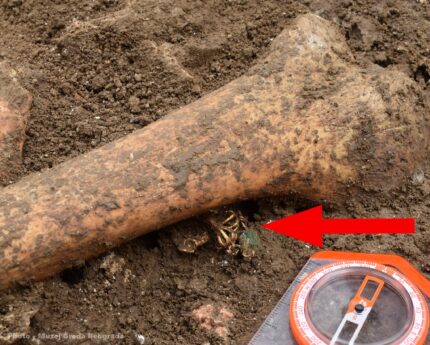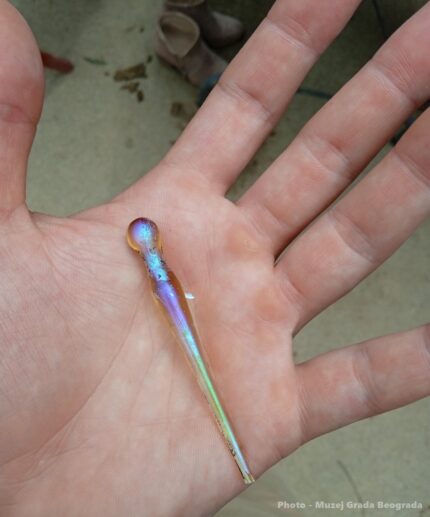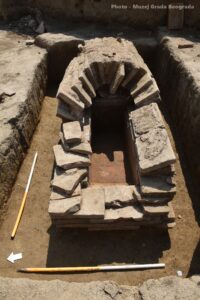 An archaeological survey has unearthed a Roman-era necropolis and a long section of Roman aqueduct in the historic center of Belgrade near the Serbian Parliament building. Fourteen Roman tombs dating to the 3rd and 4th centuries A.D. have been excavated, revealing a variety of burial styles and several significant grave goods.
An archaeological survey has unearthed a Roman-era necropolis and a long section of Roman aqueduct in the historic center of Belgrade near the Serbian Parliament building. Fourteen Roman tombs dating to the 3rd and 4th centuries A.D. have been excavated, revealing a variety of burial styles and several significant grave goods.
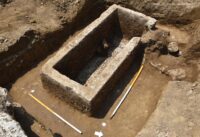 Two of the tombs are rectangular and made with brick walls and arched ceilings. Another two are brick caskets. Four of them are stone sarcophaguses, affordable only to the very wealthy. One was a sort of spoglia cist, a tomb made of other tombstones recycled from older graves. A fragment of an inscribed tombstone identifies it as the funerary marker of a Roman soldier who died at the age of 46 after serving 30 years in the legions. On the other end of the spectrum, two intact skeletons were found buried simply in a pit. Their hands were crossed on the chest and the graves were oriented east-west, indicating these were Christian burials.
Two of the tombs are rectangular and made with brick walls and arched ceilings. Another two are brick caskets. Four of them are stone sarcophaguses, affordable only to the very wealthy. One was a sort of spoglia cist, a tomb made of other tombstones recycled from older graves. A fragment of an inscribed tombstone identifies it as the funerary marker of a Roman soldier who died at the age of 46 after serving 30 years in the legions. On the other end of the spectrum, two intact skeletons were found buried simply in a pit. Their hands were crossed on the chest and the graves were oriented east-west, indicating these were Christian burials.
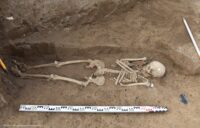 The tombs were looted in antiquity, but the thieves did not get every last thing. A fragment of a gold necklace with a semi-precious green stone was found under the bones of the deceased inside one of the stone sarcophagi. One object is particularly special due to its fragility and unique material. It’s a hair pin made of iridescent glass and in excellent condition. Hair pins were usually made of metal or bone. This glass version is the only one of its kind ever found in Belgrade.
The tombs were looted in antiquity, but the thieves did not get every last thing. A fragment of a gold necklace with a semi-precious green stone was found under the bones of the deceased inside one of the stone sarcophagi. One object is particularly special due to its fragility and unique material. It’s a hair pin made of iridescent glass and in excellent condition. Hair pins were usually made of metal or bone. This glass version is the only one of its kind ever found in Belgrade.
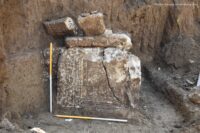 The excavated area was the southeastern part of the ancient city of Singidunum, a settlement founded by the Celtic Scordisci people in the 3rd century B.C. It was conquered by Rome in 75 B.C. and rose to importance from its association with a major fort defending the Danubian Limes (the Roman military frontier that followed the Danube). It was granted the rights of a city (municipium) by Hadrian in 169 A.D., and became an official colony in 239 A.D. The future emperor Jovian was born there in 332 A.D. The Legio IV Flavia Felix was garrisoned at Singidunum from the reign of Domitian in 86 A.D. until the Hunnic invasions of the mid-5th century.
The excavated area was the southeastern part of the ancient city of Singidunum, a settlement founded by the Celtic Scordisci people in the 3rd century B.C. It was conquered by Rome in 75 B.C. and rose to importance from its association with a major fort defending the Danubian Limes (the Roman military frontier that followed the Danube). It was granted the rights of a city (municipium) by Hadrian in 169 A.D., and became an official colony in 239 A.D. The future emperor Jovian was born there in 332 A.D. The Legio IV Flavia Felix was garrisoned at Singidunum from the reign of Domitian in 86 A.D. until the Hunnic invasions of the mid-5th century.
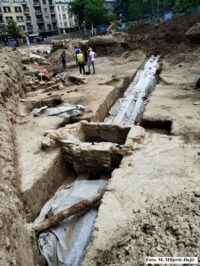 Two weeks before the discovery of the Roman graves, buried beneath Ottoman-era remains, a stretch of aqueduct emerged. The presence of a necropolis in the area was known, but a length of aqueduct 200 feet long complete with original lead pipes was an unexpected find. Archaeologists believe it was a later offshoot built in the 3rd or 4th century of the main aqueduct built by Vespasian in the 1st century and was likely used to supply fresh water to the IV Flavia Felix in the fort.
Two weeks before the discovery of the Roman graves, buried beneath Ottoman-era remains, a stretch of aqueduct emerged. The presence of a necropolis in the area was known, but a length of aqueduct 200 feet long complete with original lead pipes was an unexpected find. Archaeologists believe it was a later offshoot built in the 3rd or 4th century of the main aqueduct built by Vespasian in the 1st century and was likely used to supply fresh water to the IV Flavia Felix in the fort.
This rich archaeological site has an ignominious future in store: being paved over to make a public parking lot. The construction of the lot would destroy all the immovable ancient remains. No new plans have been made since the recent discoveries (or least none have been announced).
The City Institute for the Protection of Cultural Monuments in Belgrade is responsible for their fate . The conditions prescribed by the institute before the construction of the garage are that the archaeological heritage that will be discovered during the research should increase the monumental heritage of the entire area where, in addition to the House of the National Assembly, there is also the building of the Agrarna banka and the endowment of Đoka Vlajković,” answered Ignjatović .
“We will wait a little longer for that decision, and one of the solutions is to present the remains within the archeological park, which would be the first of its kind in Belgrade .”
